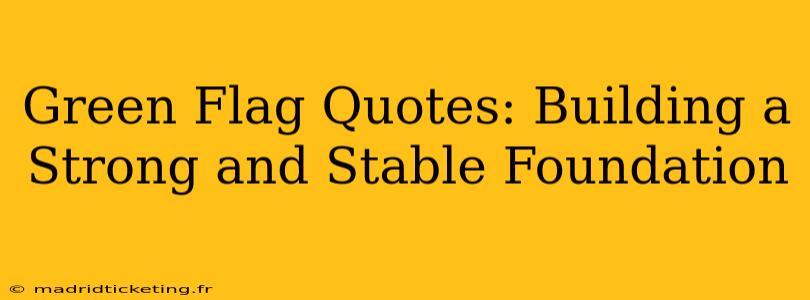Navigating the complexities of relationships can feel like traversing a minefield. Knowing what to look for in a potential partner is crucial to building a healthy, lasting connection. While red flags are often discussed, focusing on "green flags"—positive indicators of a healthy relationship—provides a more proactive and empowering approach. This article explores the significance of green flags in relationships, delving into what constitutes a green flag and how identifying them contributes to building a strong and stable foundation for a successful partnership.
What Exactly Are Green Flags in a Relationship?
Green flags are positive behaviors, traits, and characteristics exhibited by someone that signal a healthy and promising relationship. They represent qualities and actions that foster trust, respect, communication, and emotional intimacy. Unlike red flags, which are warning signs of potential problems, green flags are reassuring indicators of a compatible and supportive partner. They are the building blocks of a strong and enduring relationship. Think of them as the solid foundation upon which you build your future together.
Identifying Green Flags: Key Indicators of a Healthy Relationship
Recognizing green flags requires awareness and self-reflection. It's about understanding your own needs and values and then identifying partners who align with those values. Here are some key indicators of a healthy relationship to watch for:
Respectful Communication and Active Listening:
A significant green flag is a partner who communicates openly, honestly, and respectfully. They actively listen to your perspective, even when they disagree, and value your thoughts and feelings. They don't interrupt or dismiss your concerns and engage in constructive conversations, even during disagreements.
Emotional Intelligence and Empathy:
Emotionally intelligent partners understand and manage their own emotions, and are empathetic towards yours. They can identify and validate your feelings, offering support and understanding during difficult times. They don't shy away from emotional vulnerability and create a safe space for you to express yourself.
Shared Values and Life Goals:
While complete alignment isn't necessary, sharing core values and having compatible life goals is a strong green flag. This provides a sense of shared direction and purpose, creating a solid foundation for long-term compatibility. It reduces the potential for conflict arising from fundamental differences.
Healthy Boundaries and Respect for Personal Space:
A partner who respects your boundaries and understands the importance of personal space is a strong indicator of a healthy relationship. They don't pressure you into doing things you're uncomfortable with and understand the need for individual time and pursuits.
Commitment and Loyalty:
Commitment and loyalty are essential components of a long-lasting relationship. A partner who demonstrates their commitment through actions and words, and who remains loyal and trustworthy, provides a sense of security and stability.
Kindness and Compassion:
Kindness and compassion towards you, others, and even animals, are excellent indicators of a loving and caring partner. These qualities reflect their overall character and demonstrate their ability to nurture and support those around them.
Why Focusing on Green Flags Matters
Focusing on green flags shifts the perspective from fear-based avoidance (of red flags) to a more proactive approach of identifying positive attributes. This empowers you to actively build a relationship based on strengths and mutual respect rather than reacting defensively to potential threats.
Frequently Asked Questions (PAA)
Here are some frequently asked questions related to identifying green flags in relationships:
How do I know if I'm overlooking green flags?
Sometimes we can be blinded by our own insecurities or past experiences. Self-reflection is key. Consider journaling about your relationships, focusing on positive aspects. Discuss your observations with a trusted friend or therapist for an outside perspective.
What if my partner shows some green flags but also some red flags?
This is a complex situation. Analyze the frequency and severity of each. A few red flags might be manageable with open communication and willingness to work through issues, but consistent or severe red flags outweigh any green flags.
Are green flags the same for everyone?
While the core principles (respect, communication, etc.) remain consistent, the specific manifestations of green flags can vary depending on individual preferences and relationship dynamics.
Can green flags change over time?
Relationships evolve, and so can the manifestation of green flags. What might appear as a green flag early on might wane, while new ones may emerge. It's important to continually assess the relationship dynamic.
How do I communicate my needs and expectations effectively to ensure the relationship thrives based on green flags?
Open and honest communication is crucial. Express your needs and expectations clearly and respectfully. Active listening to your partner's needs and finding common ground is key to building a strong foundation together.
By focusing on green flags and fostering open communication, you can build a relationship that is not only stable but also deeply fulfilling and rewarding. Remember, a healthy relationship is a collaborative effort built on mutual respect, trust, and shared values. Prioritizing green flags sets the stage for a strong and lasting partnership.

